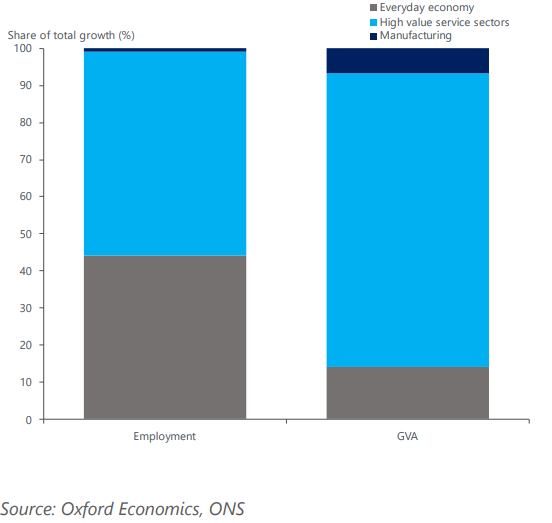UK : The everyday economy matters to local economic performance
The everyday economy generates half of all UK employment and 33% of GVA but is often dismissed because it generates less growth than high value services and has low productivity. But indirectly it has the capacity to improve the competitiveness and performance of local economies and has been identified by Labour Party leaders as a sector to focus on, if they win the election.
What you will learn:
- Discussions of how to improve local economic performance typically focus on manufacturing and high value services. But the rest, or the “everyday economy”, accounts for half of total UK employment, and in 291 out of 361 local authority districts it represents the largest share of employment—sometimes as much as two-thirds.
- Furthermore, in the decade to 2023, there were 153 local economies in which the everyday economy was the main driver of employment growth. Out of these 153, it was the main driver of GVA growth in 47, including 10 where it was the only part of the economy to experience an increase over the decade. In terms of employment there were seven LADs where the everyday economy sectors increased enough to offset decreases in high value service sectors and in manufacturing.
- But it cannot be denied that at the UK level, most of the employment and GVA growth over the 2013-23 decade was because of high value services, with a disproportionate weighting towards GVA. These accounted for 55% of employment growth and 79% of GVA growth.
- The everyday economy also has low productivity, with GVA per head of £36,900 compared with £72,000 and £76,000 for high value services and manufacturing, respectively. Ultimately, low productivity results in low wages.
- Overall, though, the everyday economy does matter, not just for the achievement of social goals but also as the foundation of the success of other sectors. If a local economy has a competitive everyday economy, it will improve the economic impact made by manufacturing and high value service sector businesses. The everyday economy plays an important role in driving local economic growth.

Tags:
Related Posts

Post
UK: Supply constraints are probably less prominent in the south
The extent to which UK employers can respond to likely 2024 interest rate cuts with increased output, rather than rises in prices and wages, will partly reflect the extent of spare capacity. This will inevitably vary by region. Evidence on this is imperfect, but in terms of capital assets (including intangibles) and labour availability, southern regions appear to be in a stronger position than those in the UK's traditional industrial heartland.
Find Out More
Post
GCC: Key themes shaping city economies in the near term
For Gulf cities, the near-term outlook will be tied not only to the global macroeconomic backdrop, but also the progress of the diverse visions and strategies in the region. With the aim to diversify their economies and reduce the dependence on oil, Gulf states continue to invest in the non-oil economy and implement various reforms. That said, oil revenues remain key to funding diversification efforts.
Find Out More
Post
Eurozone: ECB rate cut decisions won’t likely be affected by the Fed
A scenario where neither the Federal Reserve nor the European Central Bank cut rates in 2024 would reduce eurozone GDP by 0.5ppts by 2025. We still think the eurozone economy would grow by 0.5% in 2024, but the projected expansion in 2025 would be 1.4%, lower than 1.8% in our baseline forecast.
Find Out More